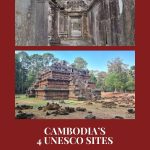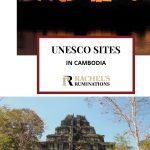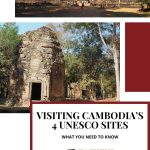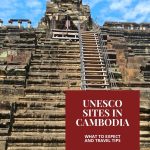UNESCO sites in Cambodia: More than just Angkor Wat!
The UNESCO World Heritage list includes all sorts of places that are considered to have “outstanding universal value,” whether that means an important ecosystem or landform or historical location or architecture or art. It’s a bit unusual that all the UNESCO sites in Cambodia are historical temple sites.
Note added July 2025: UNESCO just added another World Heritage site to Cambodia’s list, called “Cambodian Memorial Sites: From centres of repression to places of peace and reflection.” In other words, not a temple, but rather three sites related to the “Killing Fields” in Phnom Penh. I haven’t visited them, but I did see the one in Siem Reap, which you can read about here.
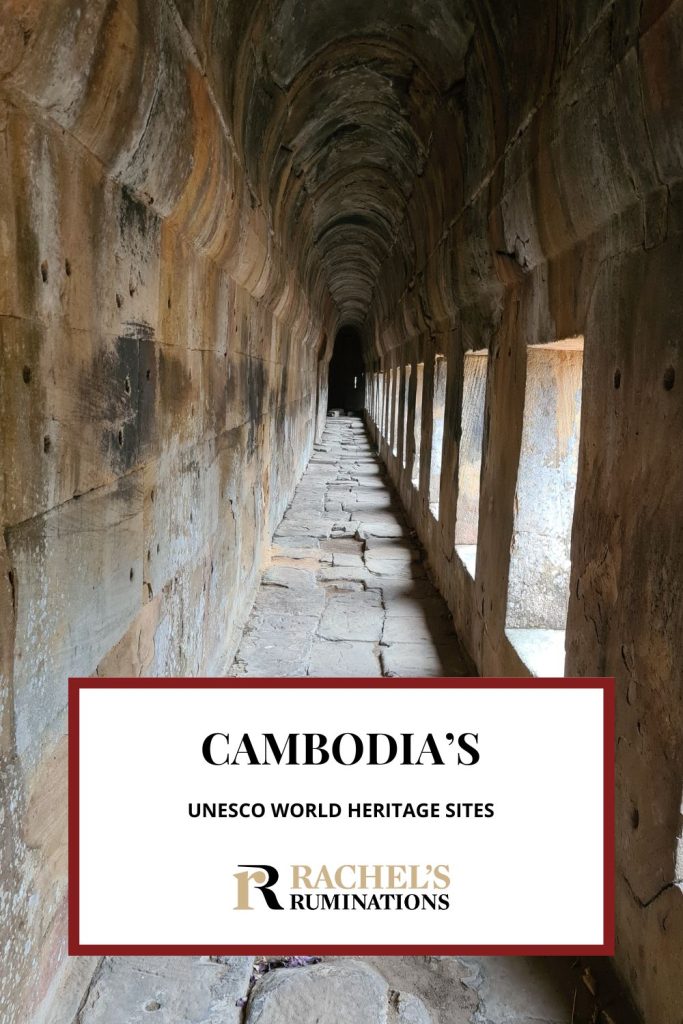
Disclosure: This article contains affiliate links. If you click on an affiliate link and make a purchase, I will receive a small commission. This will not affect your price.
To be specific, Cambodia has four (now five), though you’d never know it when you realize how often Angkor Wat gets mentioned and how you’ve probably never heard of the other three. Besides Angkor – Angkor Wat is only one part of a much larger conglomeration of sites under the official title of “Angkor” – the others are called Sambor Prei Kuk, Koh Ker and Preah Vihear.
My husband and I recently visited all four of Cambodia’s UNESCO World Heritage sites. These sites each represent Hindu religious expression of a different time period. At the same time, they represent political aspirations, since large temples and temple complexes were generally built by kings.
In this article, I’ll describe them in chronological order, placing each one’s history in context. I’ll also describe what I saw, giving my impressions of the site as well as tips for visiting each one. At the end, I’ll give my take on which one(s) you should visit.
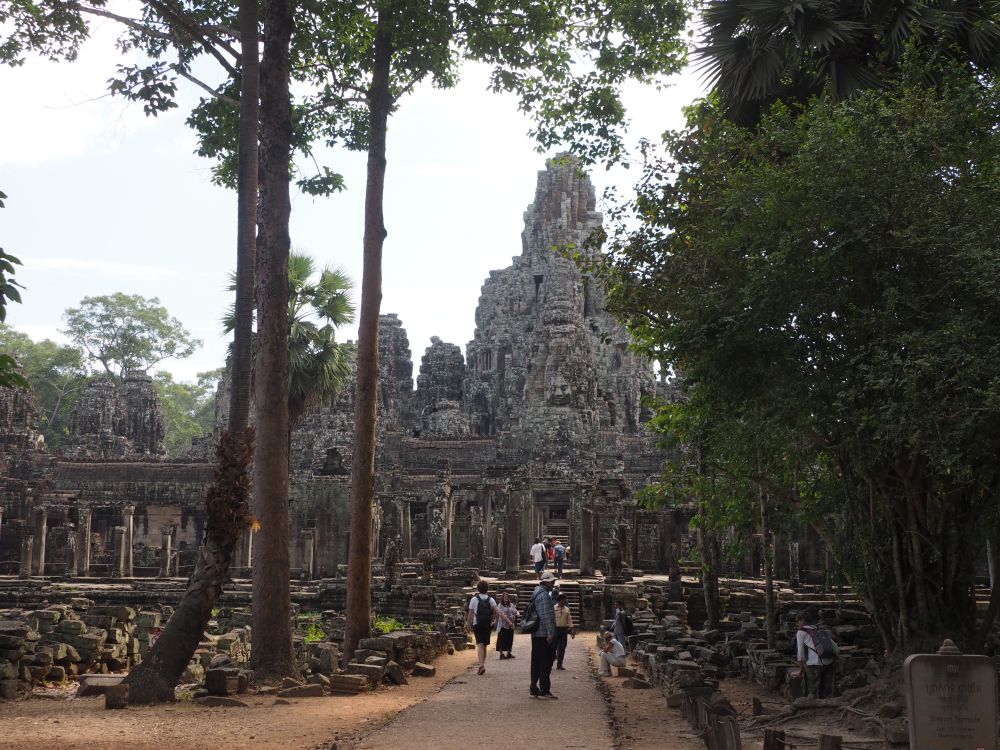
If you want to get to any of the UNESCO sites in Cambodia besides Angkor, you’ll either need to rent a car or hire a car and driver. We used a Vietnam-based tour company for a bespoke 2-night, 3-day tour. They were extremely efficient and reliable, and I certainly would recommend them. (This was not sponsored; we paid for their service.) If you’d like to contact them, send me an email – you’ll find the address under “Contact” above – and I’ll connect you. I’d appreciate it because they’ve offered me a commission for referrals.
There are plenty of other companies who offer private tours, which you can look at here and here.
1. Sambor Prei Kuk
Officially called “Temple Zone of Sambor Prei Kuk, Archaeological Site of Ancient Ishanapura,” this site is about halfway between Phnom Penh and Siem Reap. Dating to the late 6th and the 7th century AD, Ishanapura was the capital of the Chenla kingdom. The city itself was west of here, and little is left of it, since most city buildings were wooden. However, these temples were made of fired bricks for the most part, with some sandstone detailing.
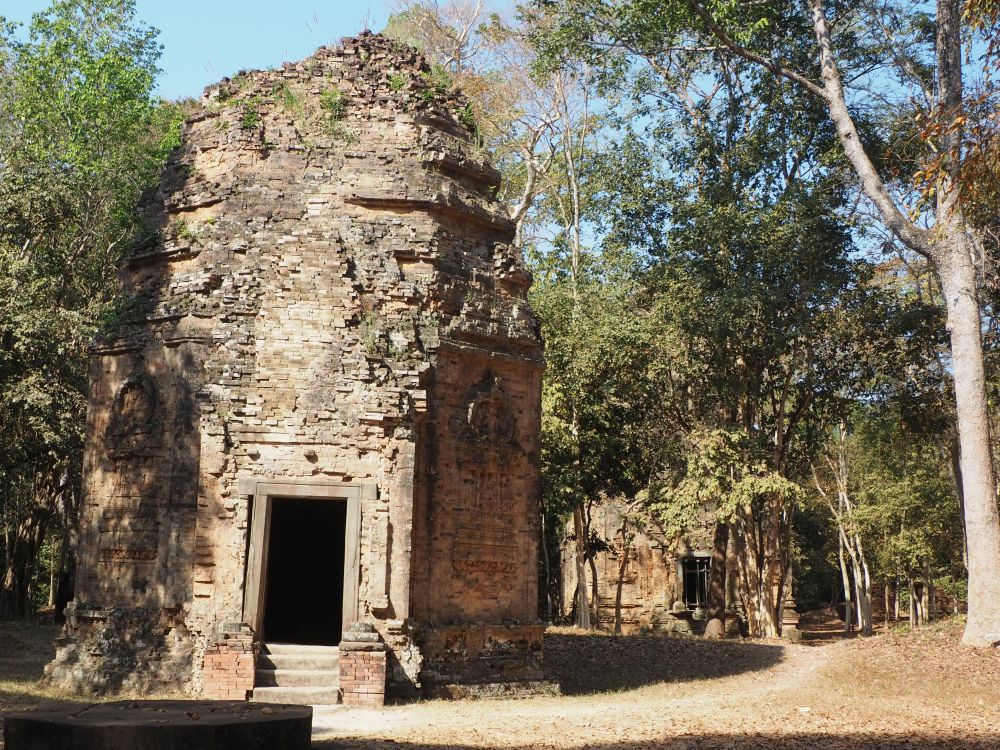
The religion practiced here was Shaivism, a variant of Hinduism in which Shiva is the supreme being, i.e. God. As seems to have been the pattern for all of the ancient temples on this list, temple-building and temple expansion and improvement was often an expression of ego: a new king who wanted to make a powerful statement would build a new temple or even move a capital. In this case it was Isanavarman I, king of the Chenla Kingdom, who founded these temples and the city of Ishanapura. The Chenla Empire later became the Khmer Empire.
What you’ll see at Sambor Prei Kuk
Of the 186 temples in Sambor Prei Kuk, only a few dozen are still more or less standing. There are three main clusters, now called Southern, Central and Northern. The Southern and Central groups were each originally surrounded by two concentric walls, made of laterite and brick, in a square shape. The Northern group had three concentric walls. Each cluster had a larger central temple on a raised platform with smaller ones surrounding it.
As you walk around the site, notice the woods around you. You’ll see many rounded bumps in the landscape. These bumps probably hide archaeological remains of where temples or other buildings once stood. They just haven’t been excavated yet.
According to UNESCO, the importance of the site has to do with the Hindu iconography, particularly the depictions of “flying palaces” from Hindu mythology on some of the temples, as well as the unusual octagonal shape of 11 of the temples.
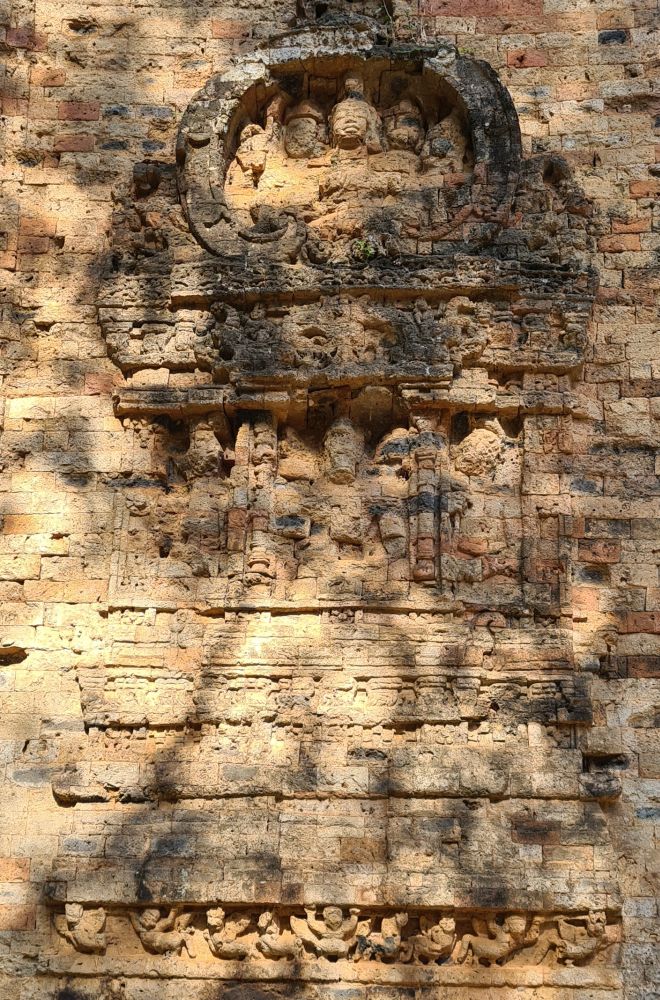
The early Khmer art and architecture influenced later styles, particularly at Angkor. After all, Angkor – so much better known than Sambor Prei Kuk – didn’t spring from nothing. It built on the developments of earlier temples like this one.
None of the temples I saw are in particularly good shape. The forest has damaged them. So has looting. Not only that, this area was a war zone starting during the Vietnam War – when it was bombed – and extending until the 1990s. It became a UNESCO site in 2017, which affords it a good degree of protection.
Some of the temples have been restored, using traditional techniques and reusing the old bricks. Other temples are visibly crumbling, or being torn apart by tree roots.
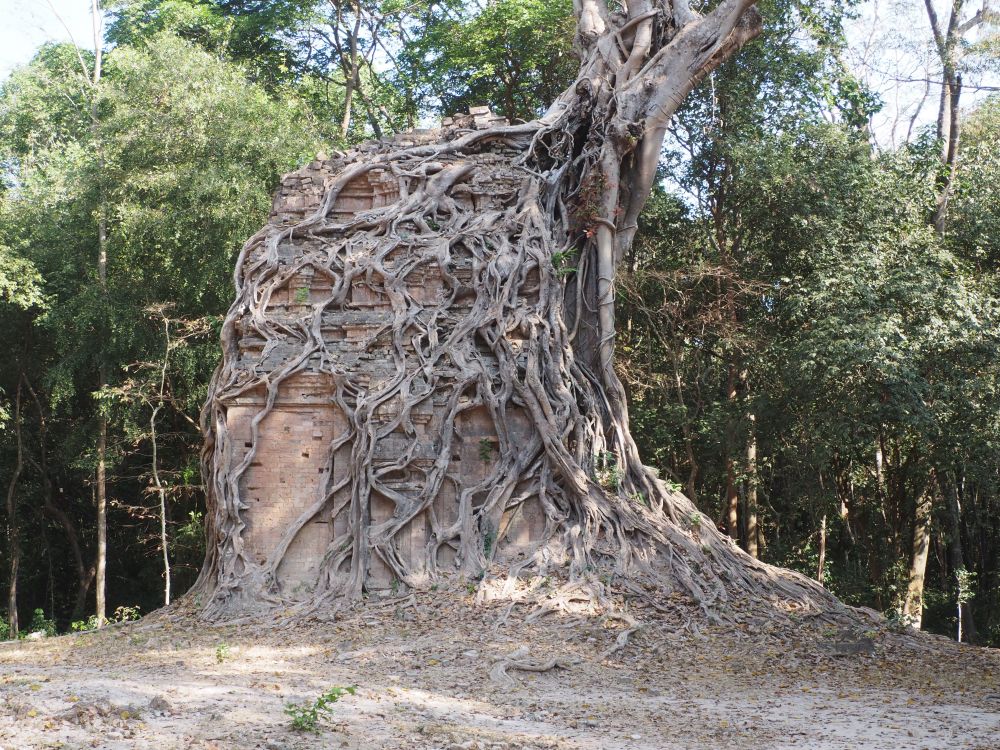
Tips for visiting Sambor Prei Kuk
The easiest way to get to Sambor Prei Kuk is to drive, either with your own rental car, a hired car and driver or as a stop on a tour.
Besides the centuries of neglect and, more recently, the warfare this area suffered during the Vietnam War and the Cambodian Civil War, guerillas at some point later planted mines around the site. That means that if you visit, don’t go wandering off in the woods. There may still be unexploded landmines.
In any case, you should probably take on a guide. After paying for your ticket at the entrance booth outside the park, you’ll find official guides in a booth inside the park. We had brought a guide, but he suggested we hire one of theirs. She was, to be honest, not the best, but that was mostly because her English was very poor. She was usually able to answer questions, but it took a lot of patience between her difficulty understanding us and our difficulty understanding her accent. Your mileage may vary depending on which guide you get, or whether you bring your own. I was happy to have a guide just because it wasn’t clear to me where we could go and where we couldn’t.
This site is mostly wooded, but come prepared with water, sun protection and good shoes for walking.
Sambor Prei Kuk is more or less wheelchair accessible – at least it is in the dry season, when we visited. The paths are not paved, but are flat sandy dirt, so you’d need a fairly robust wheelchair. You would be able to see the main temples, but not enter them because that involves steps.
To see Sambor Prei Kuk, we stayed at a very pleasant 3-star hotel: Sambor Village Hotel. There are plenty of other hotels in the area as well.
2. Koh Ker
Officially called “Koh Ker Archaeological Site of Ancient Lingapura or Chok Gargyar,” Cambodia’s Koh Ker is the country’s newest UNESCO site, just added to the list in September 2023. Lingapura and Chok Gargyar are old names for what is now known as Koh Ker. Like Sambor Prei Kuk, it was a Hindu temple dedicated to Shiva.
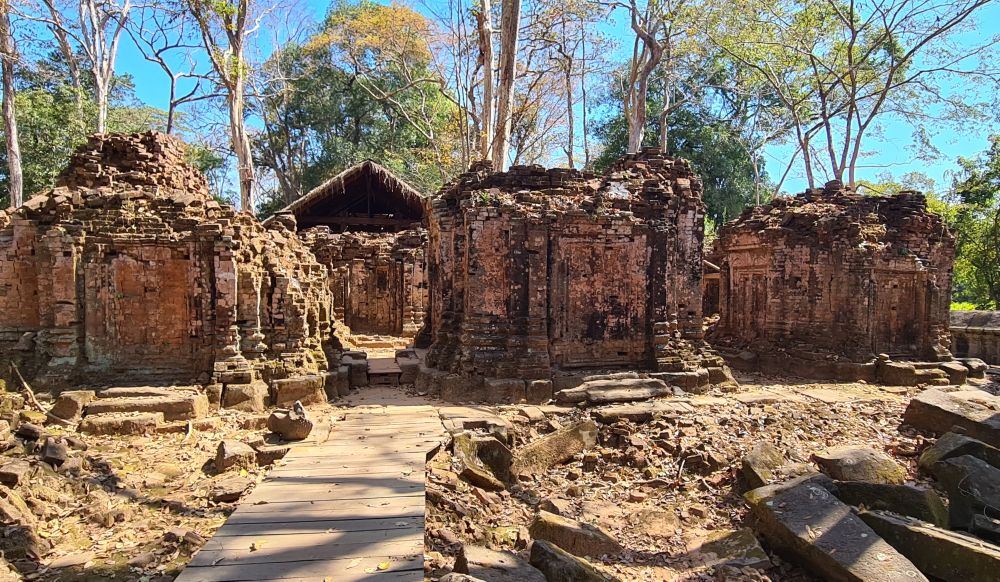
History of Koh Ker
King Jayavarman IV was the ego behind establishing a new capital of the Khmer Empire at a moment when the empire already had a capital. The two capitals, Koh Ker and Angkor, coexisted as rivals for a while. Then Koh Ker was the only capital for a very short time (928-944 AD), and then the capital moved back to Angkor.
Under King Jayavarman IV’s lead, the town planning of the new capital was based on “ancient Indian concepts of the universe,” according to UNESCO. This involved a new style, now referred to as Koh Ker Style: a combination of Indian and local influences in the artwork applied to the temples in this short period of time. The builders of Koh Ker also applied a new technology that allowed the use of very large stone blocks. This, in turn, influenced architecture elsewhere, particularly at Angkor. The shrines are made of laterite (a volcanic rock), sandstone and brick.
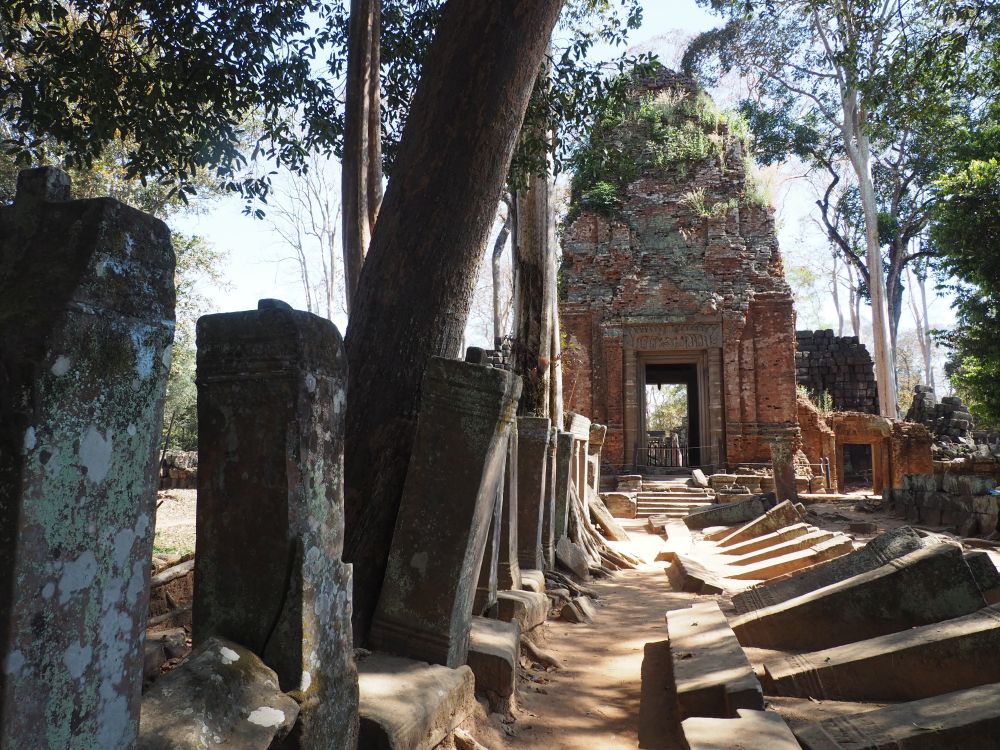
Archeological research has shown that the site was occupied a few hundred years before King Jayavarman IV’s time and continued to be an urban center long after as well. As with Sambor Prei Kuk, there is little left of human habitation as only the temples were built of stone.
What you’ll see at Koh Ker
While there are about 180 sanctuaries at the Koh Ker site, about 40 of them date to King Jayavarman’s building program. More temples were built in succeeding centuries, but only about 12 can be visited. Other sites haven’t been excavated yet and, more importantly, the whole site hasn’t yet been de-mined. The site is 81 square kilometers in size (31 square miles), according to Wikipedia.
The star of the show at Koh Ker, in my view, is the pyramid-shaped temple called Prasat Thom. It’s a stepped pyramid in seven steps, and it’s 36 meters high (118 feet). Walking the path toward it and seeing it come into view is certainly a “wow moment.” What’s more, you can climb it – not on the original steps, but on modern ones. Somehow the climb gives you a better sense for what a monumental accomplishment this structure was. Building temples with a high structure in the middle or building them at a high elevation is a representation of Mount Meru. That is where, in the Hindu belief, the gods live. In the case of Koh Ker, it’s the whole structure that represents Mount Meru.
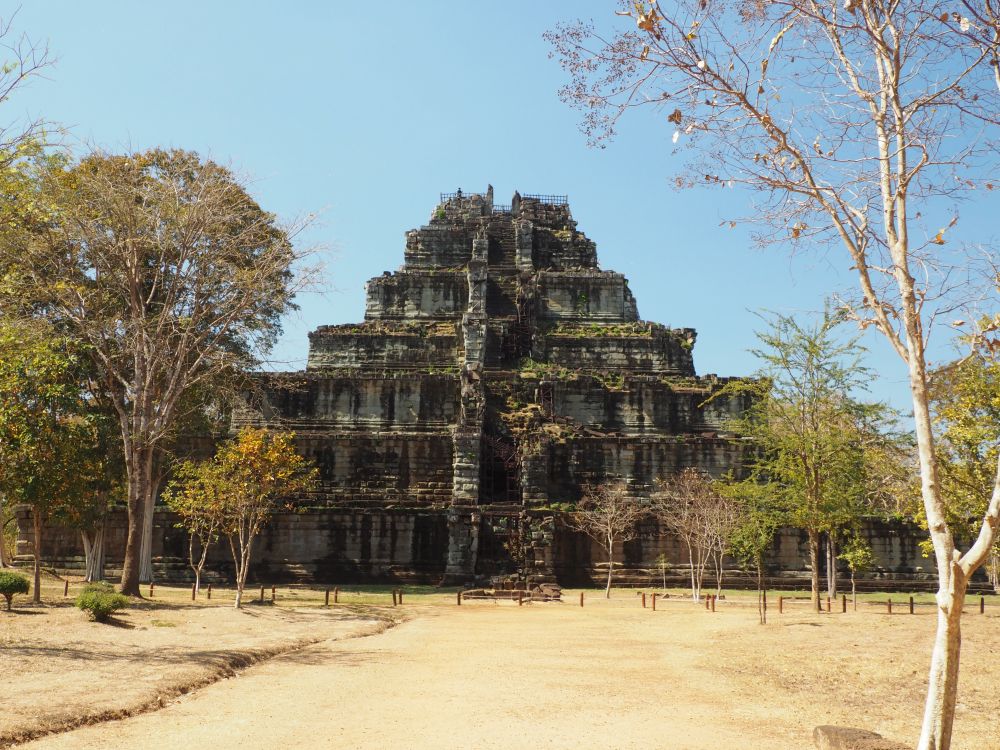
While much of the Koh Ker sculpture has been stolen for private collections or museums overseas, you can get a few glimpses here and there. Look for bas-reliefs, for example. If you climb Prasat Thom, you can see, among the jumble of rocks at the top, parts of what must have been some impressive statues.
Tips for visiting Koh Ker
Koh Ker is about 120 kilometers (75 miles) from Siem Reap and Angkor. It’s also about halfway between Angkor and Preah Vihear, both of which I’ll describe below. You can get there in a rental car or on a group or private tour.
Don’t go looking for more temples. There may still be mines at any of the unvisited temples.
Koh Ker is somewhat wheelchair accessible. At least, from the road and from the flat dirt paths, you can see some of the temples from a distance.
Book accommodations in the vicinity of Koh Ker.
3. Temple of Preah Vihear
The Temple of Preah Vihear is another Hindu temple, but this one is perched high on Dangrek Mountain, about 525 meters up. Its location is key to its story: right on the border with Thailand, it has been a subject of dispute for years. For one thing, the two countries do not agree on where the border actually is. The whole story is complicated but seems to rest on a mistake made by some French bureaucrat who drew the agreed border incorrectly. Without going into it, suffice it to say that the International Court of Justice decided in 1962 that the temple belonged to Cambodia.
Hostilities still break out between the two countries from time to time. The most recent outbreak of violence was in July-August 2025, and there are indications that Preah Vihear might have sustained some damage.
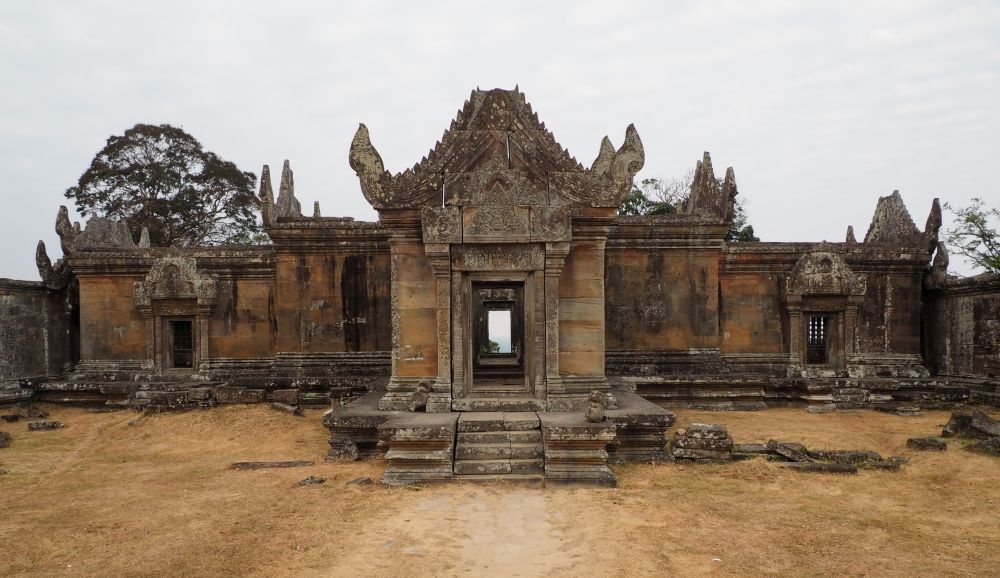
Preah Vihear’s place in modern history
The Civil War in Cambodia began in 1970, and the temple’s location on a cliff on the border made it useful militarily. It was one of the last places to fall to the Khmer Rouge, which happened in 1975.
When the Vietnamese battled the Khmer Rouge in 1978, this was where the Khmer Rouge forces retreated to. In this region, they continued as a guerilla army until their final surrender in 1998. At the very northern end of the complex, on the cliff overlooking Thailand, there’s a small shrine to the last Khmer Rouge soldier. The story goes that he committed suicide here rather than turn himself in.
Tensions between Thailand and Cambodia flared up again in 2008 partly because UNESCO accepted Cambodia’s bid to give Preah Vihear World Heritage status. The two sides exchanged fire on several occasions, with some deaths and injuries, and these military clashes continued until 2011. Hostilities started up again in 2025.
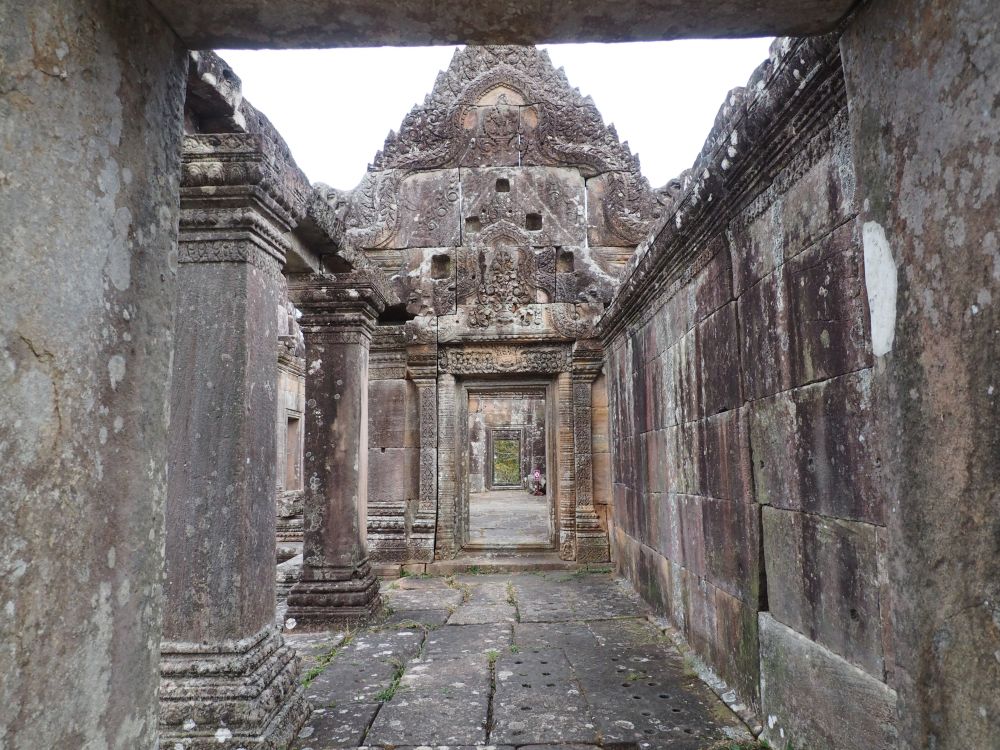
The temple complex
The temple complex is a series of sanctuaries in a north-south straight line on a high plateau, facing north toward Thailand. Siting it so high up is, again, a reference to Mount Meru. The earliest parts date to the 9th century, but the bulk of it dates to the 11th and 12th centuries, placing them in the Khmer Empire period.
The temple structures line up along an axis 800 meters long. This arrangement means that visitors of the past and today see only a small part of it at a time. As you move upward along the long axis from sanctuary to sanctuary, each one makes a strong impression. In much better condition than Sambor Prei Kuk, these structures are mostly sandstone. Much of the rich figurative carving survives.
As you walk through these impressive sanctuaries, you’ll first face two huge many-headed snakes, called Naga, at the top of a monumental entrance stairway (now partly blocked off).
Along the walkway to the first of the shrines, some Shiva-Lingas figures still stand. You’ll see the first shrine ahead of you, looking more impressive, perhaps, than it actually is because it stands at the top of a long stairway.

To your left, by the way, you’ll see a square sunken pond. This is a symbolic version of the Ganges River, considered holy in Hinduism.
When you walk through the first shrine, you’ll see the much larger temple behind it. Walking through that one will take you to a large third one. Don’t hurry, though. Notice the rich sculptural details, especially framing the doorways, and often portraying Shiva in various ways. The reason Preah Vihear is a UNESCO site is that it is, according to UNESCO, “an outstanding masterpiece of Khmer architecture. It is very ‘pure’ both in plan and in detail of its decoration.”
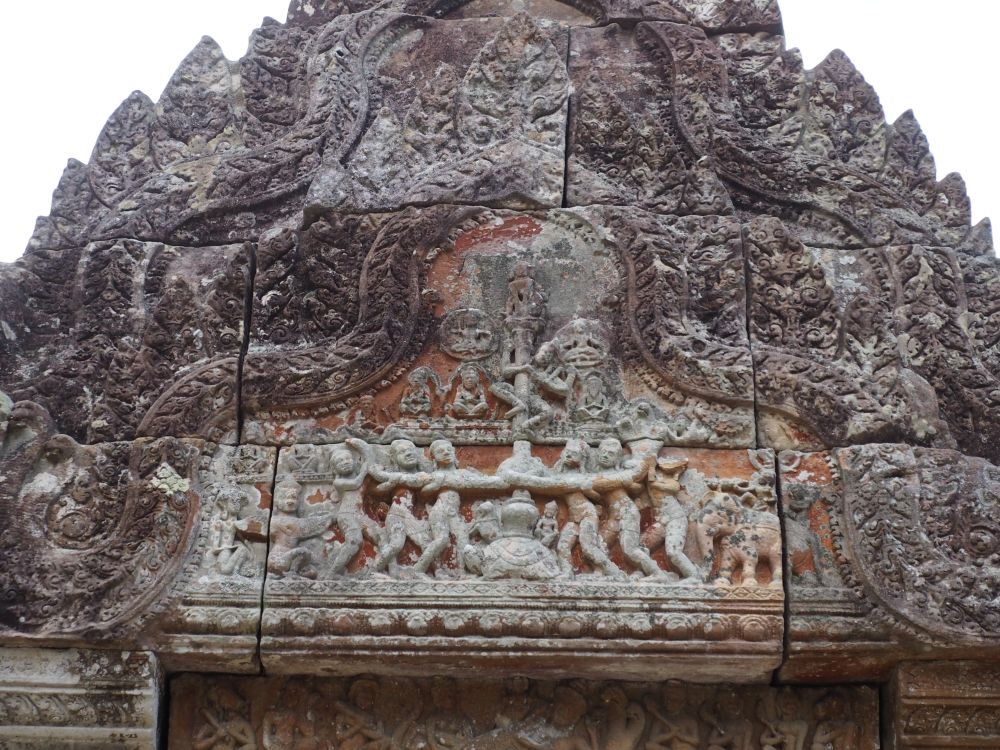
Some parts of the temples are in ruins, but others are relatively intact. You’re likely to have the place more or less to yourself as this is not a big tourist destination. Take your time to feel the isolation and to hear the distant sounds of birds or music from the nearby village. As you pass to the far end of the complex, you’ll see broad views over Thailand to the north.
Tips for visiting Preah Vihear
Check the political situation before deciding to visit Preah Vihear. Are Cambodia and Thailand still at war? Even if they’re not, is the site open for tourism?
About 45 minutes north of the town of Preah Vihear is the ticket booth for the Temple of Preah Vihear site. Visitors can’t drive much past there. Instead, you park your vehicle, and then board a four-wheel drive vehicle with a driver to go up the mountain to the site. The road is paved, but gets scarily steep. The four-wheel-drive ride is included in your entrance fee.
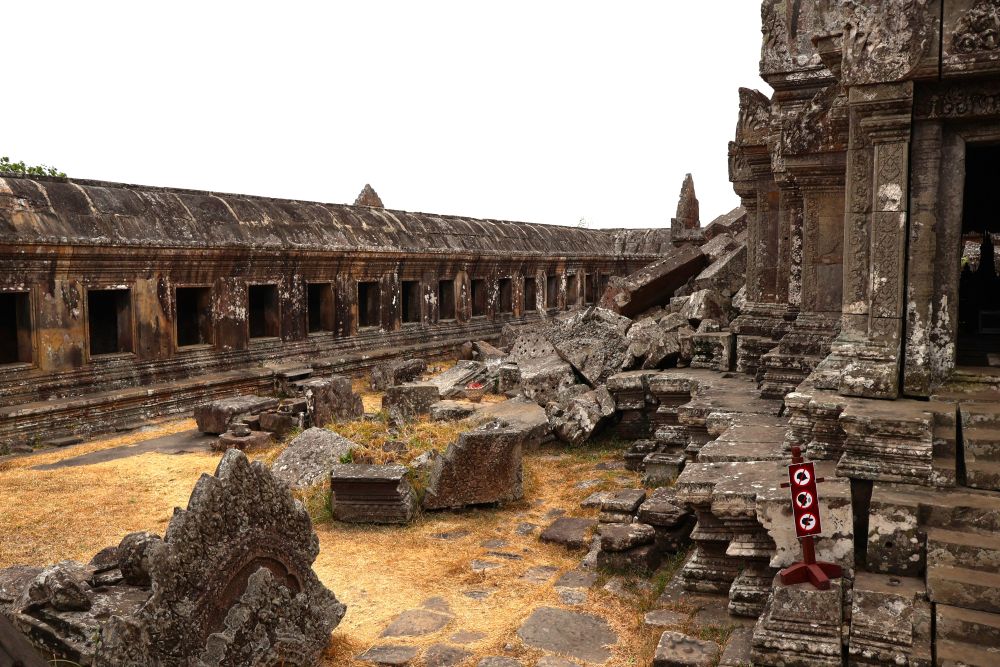
Bring water and good shoes as well as sunscreen and sunglasses.
There is nothing wheelchair accessible about this site. From the moment you step out of the four-wheel-drive vehicle, you have to climb stairs from each sanctuary to the next and within each sanctuary. To make matters worse, you can’t actually see the sanctuary as a whole from a distance.
I wouldn’t recommend the hotel we stayed at in Preah Vihear province. Here are some other ones to choose from.
4. Angkor
Angkor Archaeological Park is a collection of Hindu and, later, Buddhist temples. Founded by Jayavarman II, who considered himself a god-king, in the 9th century, subsequent rulers kept adding temples over the centuries until Angkor’s defeat by Ayutthaya in the 15th century. While people often refer to it as Angkor Wat, Angkor Wat is only one part of a much larger site. The UNESCO designation includes about 400 square kilometers (154 square miles) and over 1000 temples. In its heyday it may have had a population of over 750,000 people.
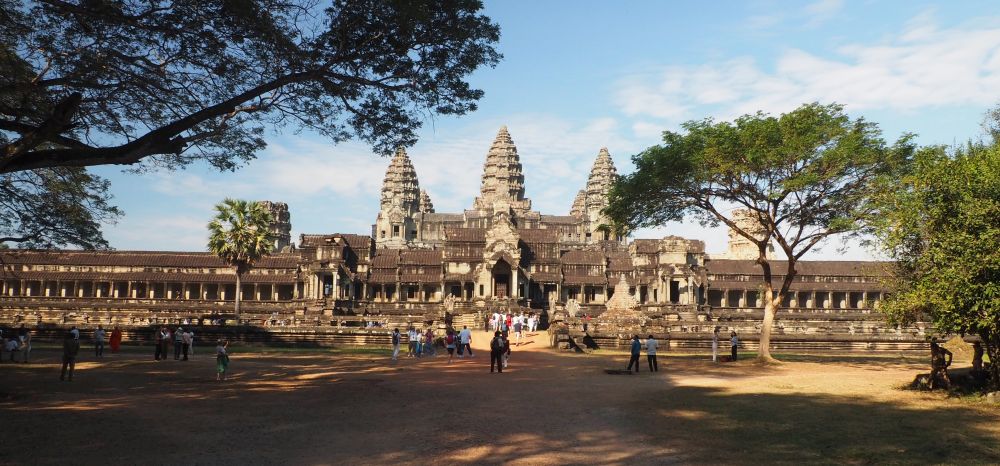
You might also like to read about Sukhothai in Thailand, the 13th-century capital of the kingdom of Siam. Ayutthaya conquered it in the 14th century, even before they conquered Angkor.
Angkor is a UNESCO site because of the importance of the art and architecture, particularly at Angkor Wat, Bayon and Banteay Srei. Influenced by India, it developed into its own style over time, and it influenced art and architecture throughout Southeast Asia. It’s safe to say that this is one of the most important archaeological sites in the world.
Since the site covers such a large area, people still live there. Whole villages and agricultural areas are located within the boundaries of the site. These, as well as the influence of large-scale tourism to Angkor, are stress factors that could threaten these widely-scattered temples. Work on research and on preservation is ongoing, often carried out and funded by NGOs or foreign government entities. At the same time as it is important to preserve the country’s tangible cultural properties at Angkor, it’s also important to preserve the intangible cultural heritage of the local Khmer people, who still use the temples in the traditional ways, for future generations.
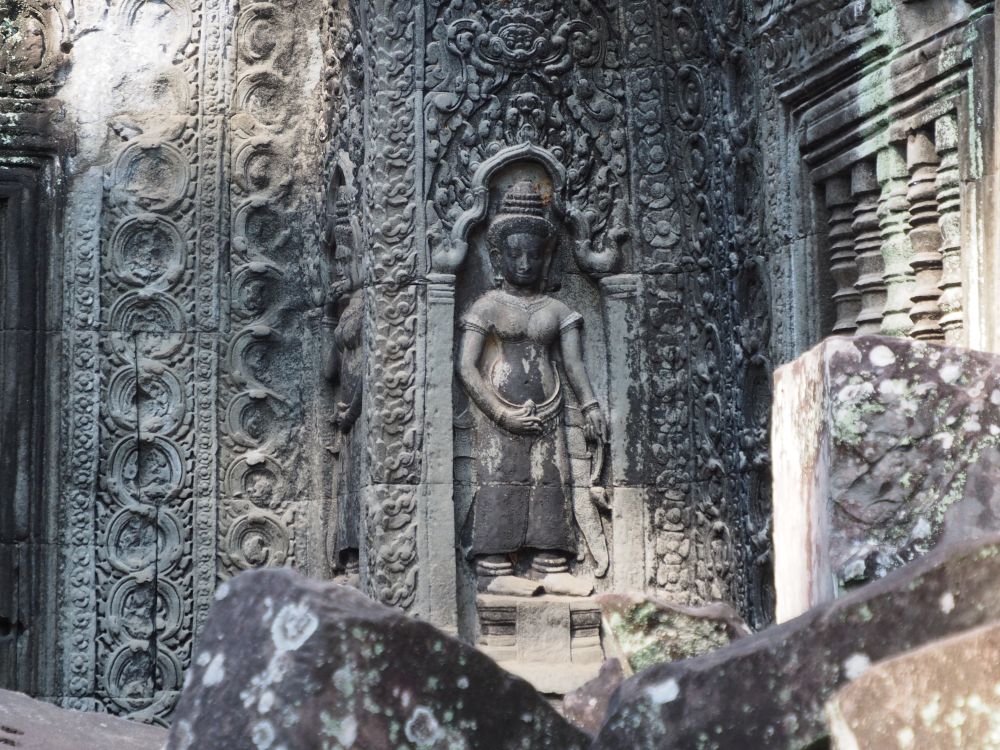
Angkor Wat
The famous temple of Angkor Wat was the capital city of the Khmer Empire from the 9th to the 15th century, except for the brief period when Koh Ker was the capital. Today little of the city remains, but the Angkor Wat temple is the largest in the region. It truly illustrates the importance and grandeur of the Khmer Empire; its walls are nearly half a mile long on each side, according to Wikipedia.
Angkor Wat was dedicated to Vishnu instead of Shiva, with the central tower representing Mount Meru. The temple includes some exquisite and very long bas-reliefs telling stories of battles and daily life under King Suryavarman in the 12th century. They are true masterpieces.
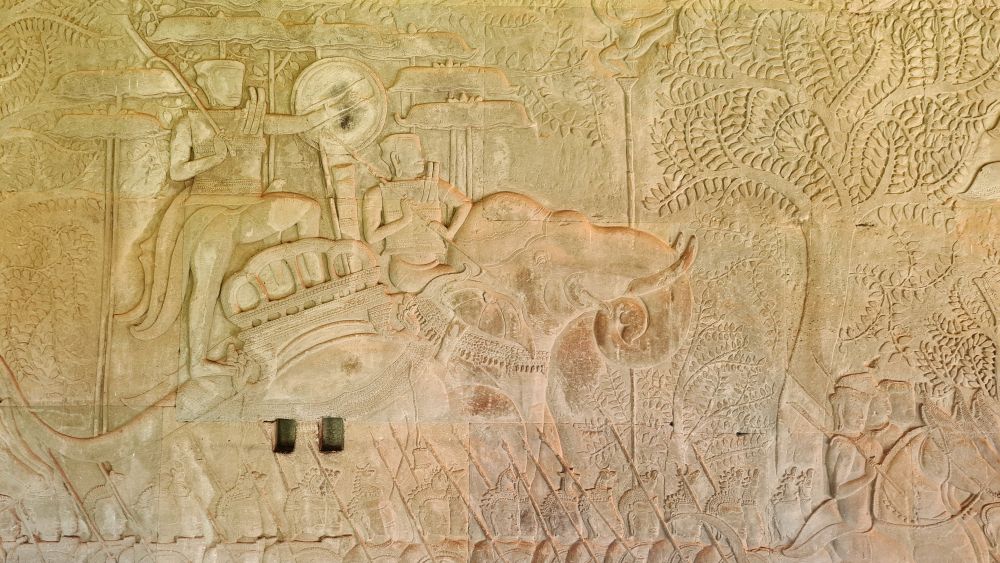
Angkor Thom
A later king, King Jayavarman VII, built Angkor Thom, and again the bas-reliefs are wonderful, showing battle scenes and daily life. Look for the huge faces on the Bayon temple in Angkor Thom as well. King Jayavarman VII was a Buddhist, and ordered that the temples be altered to show Buddha images. This didn’t last, as the Khmer Empire reverted to Hinduism after he died. Something you’ll notice at the Angkor temples here and there are Buddha sculptures with their heads cut off. Buddhism didn’t reestablish itself in Cambodia until the 14th century.
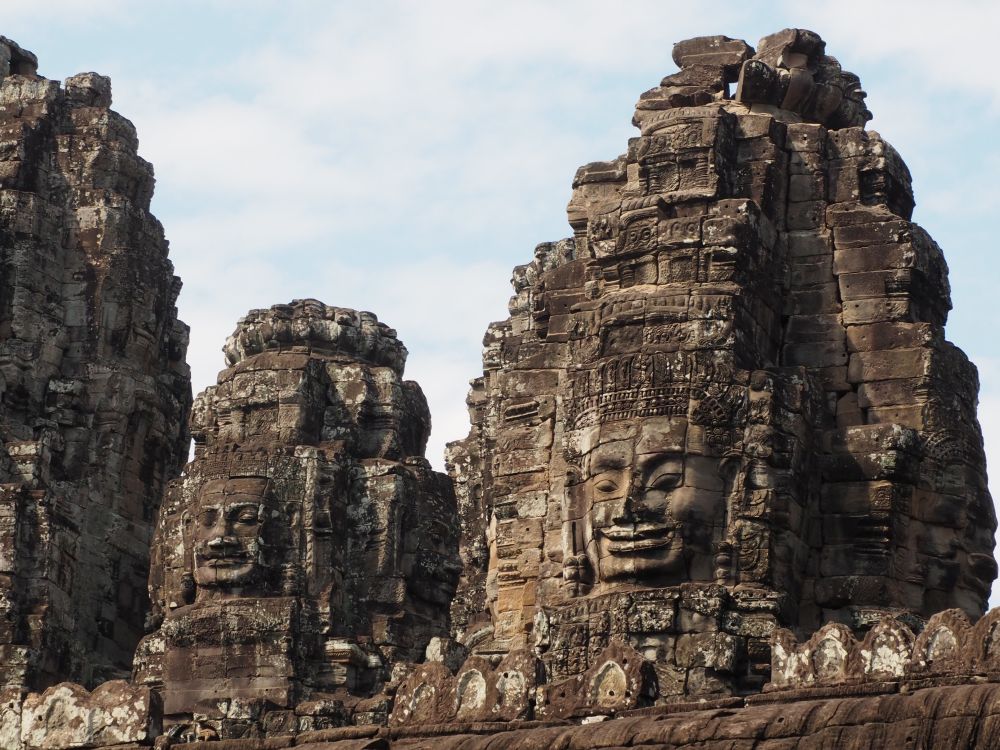
Around Ankhor Thom there is a very wide moat and a wall forming a square measuring three kilometers per side, enclosing nine square kilometers. Unusually, there are five gates in the wall instead of the usual four: north, south, east and west, but also an extra gate in the east. Our guide explained it as a death gate, for bringing the dead out for cremation or burial, but most sources I’ve read call it the Victory Gate.

Ta Prohm
Ta Prohm is a popular site for tourists because it was a set in the film Lara Croft: Tomb Raider. It’s also well-known for it’s “jungle” look: trees grow in and around parts of the temple. Like Angkor Thom, it was built by King Jayavarman VII as a Buddhist temple in the late 12th century.
We particularly liked Ta Prohm for its high Indiana Jones quotient: crumbling temples with trees growing on and through them.
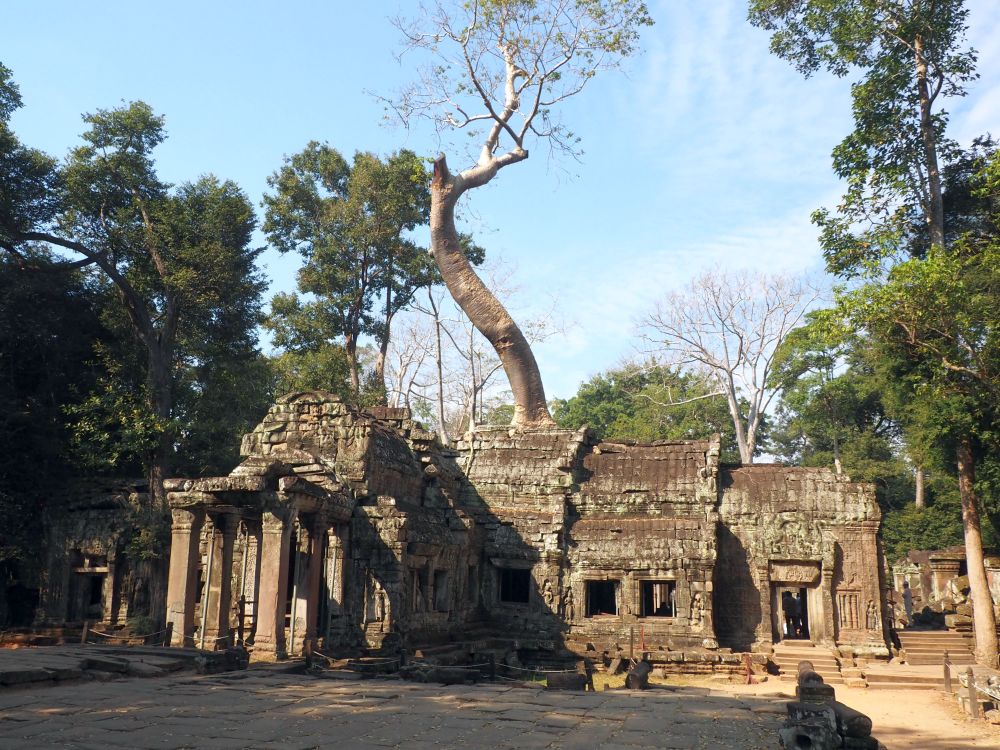
Ta Keo
Ta Keo is a pyramid temple like at Koh Ker, but with only five steps rather than seven. It was built in about 1000 AD and, again, was meant to look like Mount Meru.
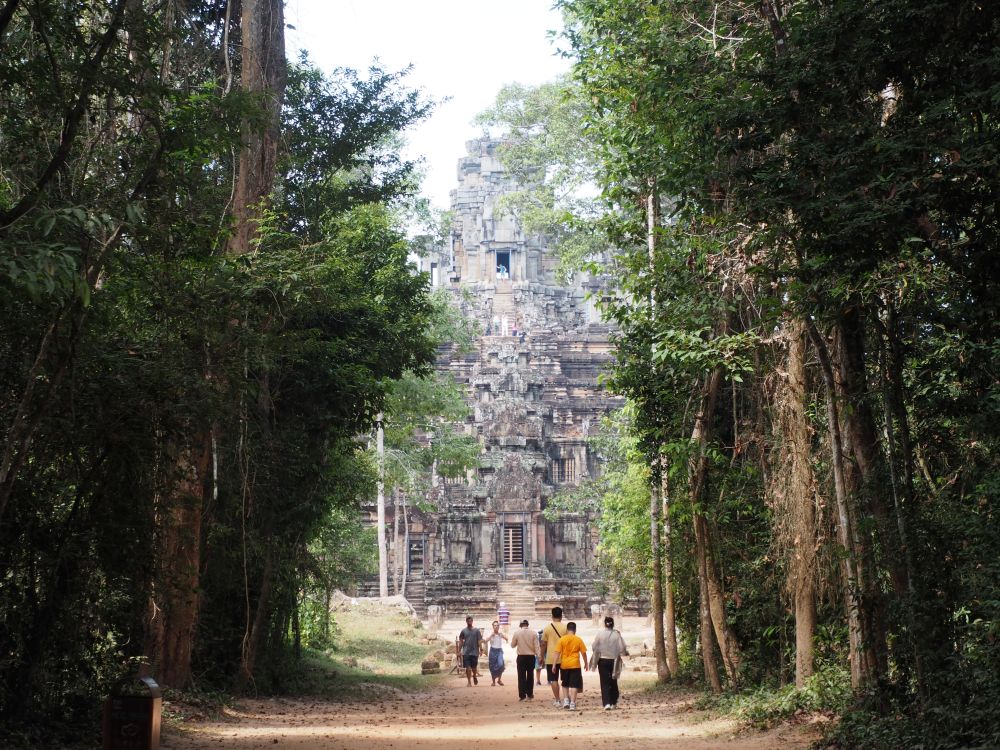
Ta Keo has four corner towers and one central one, and visitors can climb it to the top. The climb, in this case, uses the original stairs, which are extremely steep and uneven and not wide enough to fit a whole foot. I found it a real challenge, but it was worth it for the satisfaction of reaching the top. On those steep stairs, though, I wasn’t the only one who made my way back down by sitting and scooting down step by step.
Tips for visiting Angkor
Angkor is an enormously popular tourist attraction today, so no matter when you go, you’ll encounter lots of tourists. Everyone wants to see Angkor Wat and Angkor Thom, and I would certainly recommend both. The general rule, though, is that the further from these two you get, the fewer other tourists you’ll see. Even at Ta Prohm and Ta Keo, both nearby, relatively speaking, we saw fewer tourists. With a bit of patience, we were able to get photos without people in them.

While the maps make it look like the different temples and temple complexes are relatively nearby each other, they aren’t. Choose just one or two to see in a day. Hire a tuktuk driver for the day or sign up for a tour. With a guide, we saw Angkor Wat and some of Angkor Thom, Ta Keo and Ta Prohm. We had a driver to take us between sites, and we were absolutely exhausted by the end of the day. This was partly because we insisted on climbing any temples we were allowed to climb. I would suggest getting at least the three-day pass so you can take it easy.
Angkor Wat is about seven kilometers from Siem Reap. The other temples – many more than I’ve listed above – are further away and scattered over a very wide area. Hire a driver, choose an area for each day and just see that limited area.
A popular activity at Angkor Wat is to watch the sunrise over the buildings. There are two places to do so: one is inside the complex, in the large courtyard in the center. We watched it from outside the moat. Either way, it’s a breathtaking sight to see the towers of Angkor Wat emerge from the darkness.
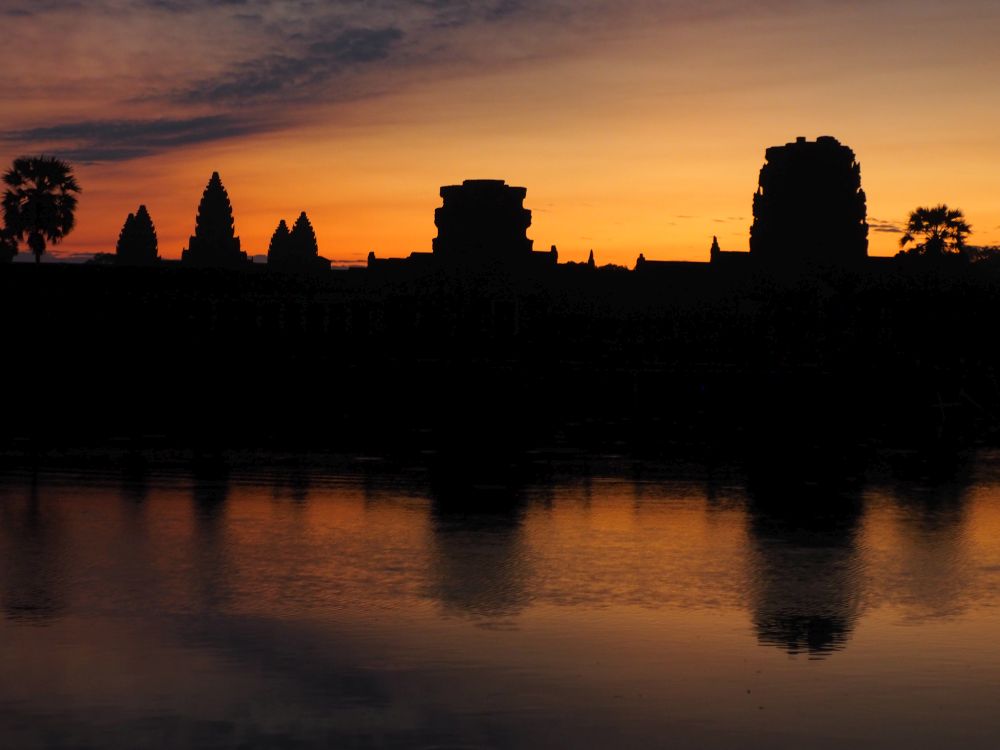
Another option is to take a sunset helium balloon ride over Angkor Wat.
You are likely to come across spots in the various temples that are still used as Buddhist temple. Be respectful by either not entering or by taking off your shoes if you do enter.
You’ll undoubtedly spend far more time at Angkor than any of the other UNESCO sites in Cambodia. Make sure to use sunscreen and wear comfortable walking shoes.
Parts of Angkor are wheelchair accessible – you can see many of the temples from the outside, and you can drive quite nearby some of them.
Siem Reap is very tourism oriented, with many hotels to choose from.
Which UNESCO sites in Cambodia should you see?
I think it goes without saying that you should see Angkor. Despite the tourist hordes, it’s spectacular and in remarkably good condition. But which other ones are worth the trip?
I would say that you can skip Sambor Prei Kuk. It was interesting, but not in good enough condition to really see the quality of the artwork or decorative elements. Though I haven’t been there, you might do better at the National Museum of Cambodia in Phnom Penh, if Chenla Empire art is what you want to see.
I loved seeing Preah Vihear. The location was awe-inspiring, and the artwork was in good condition, as were the temple buildings. I felt like I was seeing a small piece of India. (Check if the hostilities have stopped before you decide to go there.)
My husband votes for Koh Ker. To him, it gives you much more of that Indiana Jones feeling of seeing temples in the jungle, and of seeing something no one else sees. After all, it gets relatively few visitors.
So which will you visit?
My travel recommendations
Planning travel
- Skyscanner is where I always start my flight searches.
- Booking.com is the company I use most for finding accommodations. If you prefer, Expedia offers more or less the same.
- Discover Cars offers an easy way to compare prices from all of the major car-rental companies in one place.
- Use Viator or GetYourGuide to find walking tours, day tours, airport pickups, city cards, tickets and whatever else you need at your destination.
- Bookmundi is great when you’re looking for a longer tour of a few days to a few weeks, private or with a group, pretty much anywhere in the world. Lots of different tour companies list their tours here, so you can comparison shop.
- GetTransfer is the place to book your airport-to-hotel transfers (and vice-versa). It’s so reassuring to have this all set up and paid for ahead of time, rather than having to make decisions after a long, tiring flight!
- Buy a GoCity Pass when you’re planning to do a lot of sightseeing on a city trip. It can save you a lot on admissions to museums and other attractions in big cities like New York and Amsterdam.
- Ferryhopper is a convenient way to book ferries ahead of time. They cover ferry bookings in 33 different countries at last count.
Other travel-related items
- It’s really awkward to have to rely on WIFI when you travel overseas. I’ve tried several e-sim cards, and GigSky’s e-sim was the one that was easiest to activate and use. You buy it through their app and activate it when you need it. Use the code RACHEL10 to get a 10% discount!
- Another option I just recently tried for the first time is a portable wifi modem by WifiCandy. It supports up to 8 devices and you just carry it along in your pocket or bag! If you’re traveling with a family or group, it might end up cheaper to use than an e-sim. Use the code RACHELSRUMINATIONS for a 10% discount.
- I’m a fan of SCOTTeVEST’s jackets and vests because when I wear one, I don’t have to carry a handbag. I feel like all my stuff is safer when I travel because it’s in inside pockets close to my body.
- I use ExpressVPN on my phone and laptop when I travel. It keeps me safe from hackers when I use public or hotel wifi.



